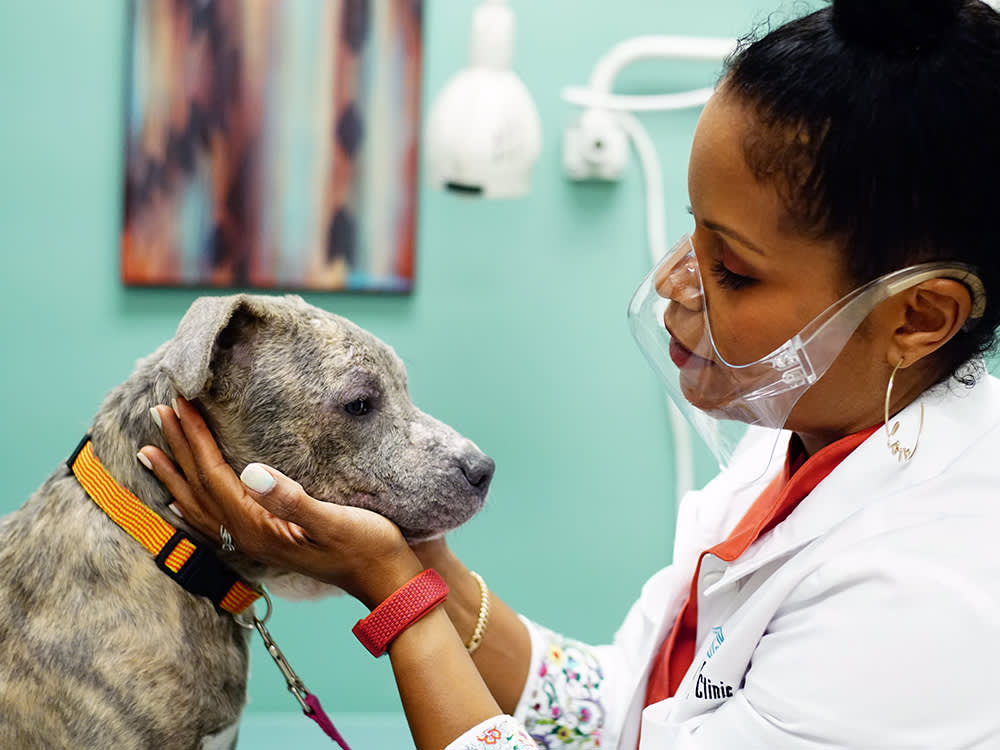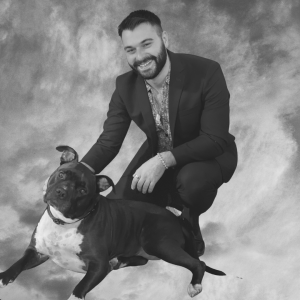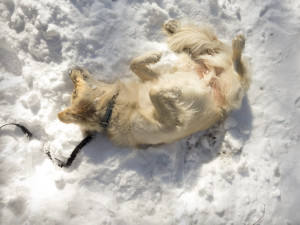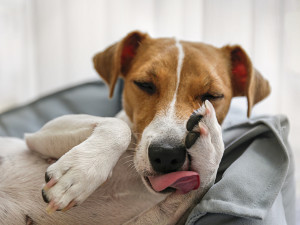Dr. Joya Griffin Is Poppin’ Puppy Pimples on TV
The star of National Geographic’s Pop Goes the Vet on the understated specialty, reality TV, and finding fun in the gross.

share article
When Dr. Joya Griffinopens in a new tab began her veterinary journey at Cornell University, she was in a similar spot to most people — unaware that veterinary dermatology existed. But Dr. Joya didn’t discover the specialty through her studies. Instead, it was thanks to a new dog her father had brought home to offset her impending absence. Unfortunately, there were complications. “Her skin was terrible. It looked like it was peeling off. It was bleeding. It smelled bad,” Dr. Joya remembers. After failing to find proper care locally, the family was referred to a veterinary dermatologist who was quickly able to resolve the problem. “They were able to make this beautiful transformation of her skin. Her hair regrew, and she didn’t smell anymore. But more than anything, they gave us our dog back. That’s when I fell in love with it,” she explains.
Roughly two decades later, Dr. Joya is not only a successful veterinary dermatologist herself but possibly the most passionate professional in the field — even when things get...foul. It’s this enthusiasm that led to Pop Goes the Vet with Dr. Joyaopens in a new tab, a National Geographic reality show. Currently streaming on Disney+, the series follows Dr. Joya and her staff as they care for patients at their Kentucky-based animal dermatology clinic. The Wildest recently spoke with Dr. Joya about the show, veterinary dermatology’s growing relevance, and enjoying the more, er, graphic parts of her work.
What’s the origin of Pop Goes the Vet?
It really started with me saying yes. There was a producer looking to make a veterinary version of Dr. Pimple Popperopens in a new tab. I think everyone loves her show. If you haven’t seen it, it’s gross. She pops all these cysts and things off people and it’s like watching a train wreck — you shouldn’t look at it, but you do. So, they were looking for a veterinary version of that. I received an inquiry and started interviewing and sending in videos and pictures of myself working at the clinic, showing all the things that I do which go beyond poppings. That’s how it started.
There are parts of your work that are equally, if not more, graphic than Dr. Pimple Popper. Were there ever any conversations about minimizing that for the show?
I think that initially they did want a lot of shocking, gross, and gruesome-type things because they were trying to make something that would appeal to that Pimple Popper audience. But what we do goes beyond just popping things and cutting off gross masses. We treat sad skin diseases that affect the look of the pet. Of course, we also treat many ear diseases, so it showed a lot of other things. But unfortunately, or maybe fortunately, a lot of dermatology is a little bit graphic. That’s the beautiful part of dermatology for me, though. It’s such a visually distinctive specialty that you can really see the change from things looking pathetic, [dogs] with no hair and sores all over their skin, to looking beautiful again. That’s one reason why I really love it.
After watching the show, it’s clear how much you genuinely love your job — even the gross parts of it. Did you always have this fascination with the grotesque?
No, I don’t think so. As a child, I just really wanted to be a veterinarian because I loved animals. I felt I had a special connection with them and wanted to spend my life working with them. At that point, like most of America, I didn’t even know veterinary dermatology existed. So, when I went into veterinary medicine and went to school for it, I really had no idea about the joys of dermatology.
I guess as a girl and someone who likes makeup, hair, and clothing, you want things to look pretty. And so that’s kind of the challenge for me. When I have these gross-looking creatures come in, [I] think, I can make this better. I can make them look beautiful again. But more importantly, I can restore the health of the animal and help them feel better so that they can go back to their families. Plus, it strengthens that human-animal bond that we so much want with our pets.
You also use a lot of humor while you work. Given the gravity and appearance of many of the conditions your patients face, how does this help make pet parents feel better?
It helps to build their trust and lighten the mood because it is sad to see your animal like that. Most of the time, these skin diseases don’t happen overnight, and they’ve been dealing with it for months. It’s a serious medical problem for their pets, but I’m letting them know that they’re in good hands and that we’re in this together.
Trying to lighten the mood a little bit helps because it can be devastating to people, and by the time they come in to see me as a veterinary dermatologist they’ve probably already spent hundreds, or even thousands, of dollars trying to get an answer as to what’s going on. So, it can be very tough and sometimes the diseases that these animals have are lifelong or life-threatening. But most of the time we can get them to a better place where they can live long, happy lives again.
Why do you think dermatology works for a TV show versus any other veterinary specialty?
It’s so visually distinctive — you can see the before and after. It’s like those old makeover shows. You can make such a visually beautiful transformation in animals. It is harder than some of the other vet shows in the sense that skin heals slowly. If you watch some of the other vet shows, they could take a mass out of the abdomen and like a day later the dog’s doing better, or they can do surgery and remove a foreign body, and the dog is better in a couple of days. But with dermatology, it takes months. In that sense, it’s sometimes harder to film because it’s not going to be instantaneous. You’ve got to stick with the patient for several months — often with some of these really bad diseases — to see that before and after so beautifully done.
Pop Goes the Vet has been streaming for a little over 10 months at this point. What has the response been like so far?
We’ve had really great feedback. We also have new clients coming from all over now. I’ve had some people from Illinois, Pittsburgh, West Virginia, and Ohio quite a bit. These pet parents are coming from much further out than where we typically would see our clients come from, which I just love because they’ve seen what a great job we do. We also have had great opportunities with mentorship. I have children from as young as three to college — and veterinary students that are setting up externships with us or even just coming by the clinic to say “hi” and have a tour. That has been the best part of this thing and something I didn’t really expect. Students ask me about how they can become veterinary dermatologists and what can they do to learn more.
What else do people say they find inspiring about you and the work you do?
I get a lot of feedback from parents saying that they love seeing a working mom, especially from ones with younger children. And because we are so playful on the show, it appeals to little kids. Then also just being a person of color, that’s very inspiring to little Black children — especially girls.
How prevalent are skin diseases and what steps should pet parents take to minimize their risk of them?
The most common disease by far that we treat is allergic dermatitis or atopy. A lot of animals suffer from allergiesopens in a new tab, but the problem is you don’t start to see symptoms until they’re a couple of years old. What the average pet parent might notice is itchy skin opens in a new tab— the dogs chewing, biting, scratching themselves — or they’re having recurrent ear infectionsopens in a new tab. Those are the most common things that they’ll see early on. Most family practitioners can handle it, initially at least. They can try some things to control the infections and to keep the itching under control. But if they’re going back multiple times or if they’re having sores and hair loss, it’s not resolving. Then it would be good to find a dermatologist to deal with that.
What’s next for Pop Goes the Vet. Can we announce season two?
I don’t know; I haven’t gotten the word for it. I desperately would love to have a second season. I think in this day and age with television, it can be really challenging because there’s so much content out there, so I really don’t know. But you can send Nat Geo a message for me.

Sean Zucker
Sean Zucker is a writer whose work has been featured in Points In Case, The Daily Drunk, Posty, and WellWell. He has an adopted Pit Bull named Banshee whose work has been featured on the kitchen floor and whose behavioral issues rival his own.
Related articles
![Indy, a woman with brown deadlocked hair, sitting next to a sunflower outside while holding a blind white dog named Okra]() opens in a new tab
opens in a new tabUrban Farmer Indy Srinath’s Pup Okra Lives the West Coast Granola-Fantasy Life
The star of the new Nat Geo series Farm Dreams feeds her pup fresh popsicles and foraged kelp.
![Winterizing your dog's coat - Dog laying in the snow.]() opens in a new tab
opens in a new tabNatural Remedies for Dry Skin: How to Help Dry Skin on Dogs
Spoiler: These at-home remedies are probably already in your pantry.
![Fluffy brown and white puppy dog scratching a lot with its paw]() opens in a new tab
opens in a new tabYour Itchy Dog Deserves Relief—Here’s What to Do
How you can help them feel better fast.
![A Jack Russel terrier licking its front paw on dog bed.]() opens in a new tab
opens in a new tabEverything You Need to Know About Lick Granulomas
Acral lick dermatitis is a frustrating skin condition, but new treatments offer hope.



